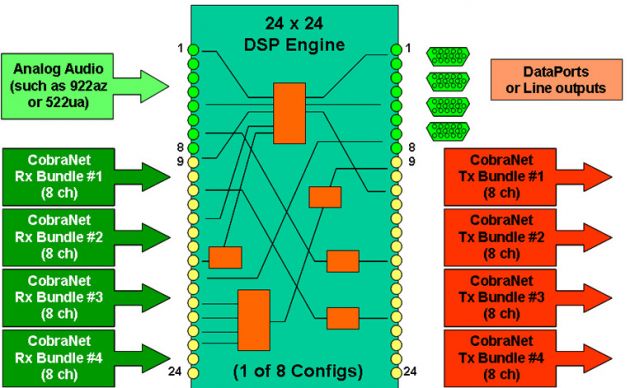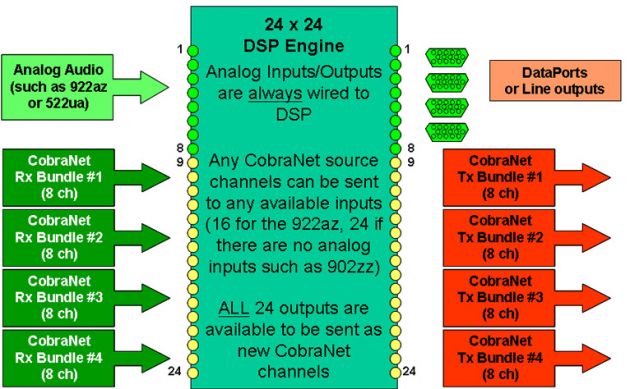Lesson Description
DSP Engine
The BASIS DSP engine can be looked at as a 24 input by 24 output chip even though it is actually six individual DSP chips sharing resources and circuitry such that they act as if they were one chip.

Analog inputs and outputs are always wired to the DSP engine, whether
they are used or not. While it could have been designed so only the
inputs you intend to use are actually connected to the DSP engine, that
approach would have been more costly to implement with little practical
advantages. In the long run, the current scheme is elegant and cost
effective. The same is true for outputs, whether they are DataPort
outputs or line-level Euro-block connectors, they are always wired to
the outputs of the DSP engine. And all the analog inputs and outputs are
pre-wired with a one-to-one relationship to the DSP channels. If you
connect to the first Euro-block input, that's DSP input one and so on.
The DataPorts are labeled A, B, C, etc., so if you connect to the third
DataPort, "C", then you are using DSP outputs 5 and 6.
Within
the DSP, any input can be routed through a number of DSP functions such
as mixers, filters, delays, and so and then to any of the outputs. Any
analog inputs can be routed to CobraNet outputs or analog outputs and
any CobraNet inputs can do the same. Up to eight different mappings or
configs of these connections can be stored in the BASIS device, and
recalled at will.
CobraNet Routing

If a BASIS derivative has CobraNet capability (not all models have
CobraNet), then any DSP inputs not already pre-wired to analog inputs
may be used as CobraNet inputs. In the case of the 922az, for example,
there would be up to 16 available inputs for CobraNet signals, while a
902zz (which has no analog inputs at all) can accept up to 24 CobraNet
signals for processing by the DSP engine. Any CobraNet-capable BASIS can
receive up to four CobraNet bundles at the same time, with up to eight
channels present in each bundle for a total of 32 CobraNet inputs. You
can select any of those signals to connect to the DSP engine, up to the
number of available DSP inputs. CobraNet channels do not have to be
assigned to DSP inputs in any particular order. You could assign three
channels from RxA, two from RxB, and seven from RxD, for a total of 12
CobraNet signals. By using configs, you could have up to eight configs
with different CobraNet channels assignments, even using different
bundles.
Outgoing CobraNet signals can be populated into
bundles of up to 8 channels per bundle. Four bundles can be used
simultaneously as outputs, for a total of 32 channels. Unlike the
inputs, which are limited to the inputs that are not already pre-wired
to the DSP engine, all 24 DSP outputs are always available to be sent as
CobraNet signals, even for those DSP outputs already pre-wired to the
analog outputs. You can truly send 32 channels of CobraNet audio, but
since the DSP only provides 24 separate outputs, then 24 CobraNet
channels would be unique sends, while the eight remaining channels would
be copies of one or more of the 24 outputs. Like the inputs, you don't
have to always send all four bundles, nor does a bundle have to be fully
populated with eight channels. It is possible to have a config with
only 2 channels of CobraNet audio, and another config with 8 channels of
CobraNet audio, and yet another config with 32 channels of CobraNet
audio.

